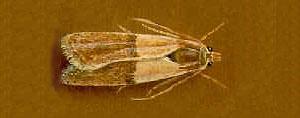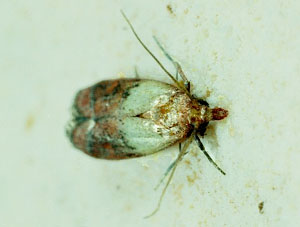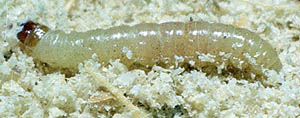
courtesy Canadian Food Inspection Agency

photo: Clemson University

photo: Clemson University
BUG OF THE MONTH SUPPLEMENT
One Man's Battle with Indian Meal Moths
Plodia interpunctella
Order Lepidoptera, Family Pyralidae
Copyright © 2003 by Gerry Conley
This article originally appeared in Scarabogram, July 2003, New Series No. 279, pp. 2-4; with additions in August 2003, No. 280, pp. 2-3.
I knew I had an infestation of Indian Meal Moths (IMMs), Plodia interpunctella. When one set off my alarm system while I was out of town (a $135 fine), I realized it was past time to get them out of the house. My first move was to buy a pheromone trap, a sticky sided, cardboard triangle with a place for the pheromone lure. Two-trap packages for $9.
 |
| Adult Indian Meal Moth courtesy Canadian Food Inspection Agency |
 |
| Adult Indian Meal Moth photo: Clemson University |
 |
| Indian Meal Moth larva photo: Clemson University |
The problem was in the kitchen cupboard above the oven where we store plastic bags of bulk products. It was easy to spot infestations. The larvae constantly emit a silk thread out of their lower lip. Where they are active, the food particles clump together noticeably. Also, I could easily see larvae feeding on the surface of cracked bulgar and rice; they grow to the size of a rice grain before they pupate.
Plastic does not stop the larval stage; they bore right through it. The holes are small and hard to see. I took an infected bag, and filled it with water; water squirted from more than a dozen holes. The larvae prefer to leave the food source to pupate and will at times crawl to another part of the house. I found them under the lazy Susan holding the grain and in other parts of the cabinet, but many contented themselves with pupating in a fold of the plastic bag.
I knew from past experience that walnuts are a preferred IMM food and had them protected in a glass jar, ditto for almonds. But cashews are clearly acceptable; my bag was damaged beyond salvage. Hazel nuts were in a heavy plastic container but were also contaminated; in this case the larvae were boring into the whole nuts and thus hidden from sight, but there was telltale frass and an adult moth in the jar! I also found them in brown and white rice, bulgar, corn meal, and raisins which I believe are their number one choice because of the moisture. I chose to treat most of the food rather than toss it. My treatment options were: a) 4 to 7 days in the freezer at 0°F. I chose this for most items (reducing the moisture problem by using sealed containers and keeping them closed until the contents had warmed to room temperature.) b) 5 minutes in a microwave* (surely lethal but I didn't want to cook the food.), c) one hour at 140° in the oven, or two hours at 120° when the food is spread out on a tray. I used this for the pistachio nuts and it cooked any existing larvae without damaging the nuts. d) dried fruit can be placed in cloth bags and dipped in boiling water for 6-10 seconds to kill external pests. Ohio State University Extension, the source of these options, explains that contaminated food can then be sifted to remove the remains, but eating a few is not harmful. I found that larvae killed by freezing turn black and are easily removed from contaminated rice. [* Yr editor does not recommend the microwave option. Insects may be killed if the adjacent material gets hot enough, but tiny insects themselves are of the same order of size as a microwave wavelength and sometimes seem to be almost immune to the heating effects.]
I realized the first line of defense is not to have any larvae, because larvae can eat through cardboard or plastic, crawl up through the threads of a loose lidded jar, or out the neck of a bag tied with a twist tie. I found frass in a piece of shredded wheat that had dropped to the bottom of the cereal drawer. Any food that a moth can lay an egg on is a problem because that can generate larvae that can crawl to other places and chew into food boxes. After cleaning out known infestations and locating all the pupating larvae I could find, I put up my pheromone traps and focused on dealing with moths.
I wondered whether adults could chew into cartons or through plastic bags. All my life I have heard of clothes moths eating woolens. But moths have no chewing mouth parts. Practically all moths eat nothing; the very limited exceptions are the moths that have special mouth parts for taking nectar from flowers. It is the larvae of clothes moths that eat woolens: members of the Tineidae family, they have the unique ability to digest wool protein and can also eat spider webs and feathers. I was relieved that IMM adults weren't going to eat into boxes and bags. But their larvae could do so if the adults found crumbs on which to lay their eggs on the shelves. I learned that IMMs can detect cracks and holes in packaging and will lay their eggs there so the larvae can move to the food after hatching. I concluded I wanted to kill all female moths before they got into my food cabinets.
|
A Macabre Experiment |
The pheromone traps I bought stated they killed thousands of moths. But this includes the ripple effect. Over the next two months I trapped 25 moths in the single trap I put in the upstairs kitchen. All had to be males, as only males are attracted to the pheromone. Half the moths that hatch out would be expected to be males and half females. Catching 25 males by pheromones told me to expect 25 females not attracted to the pheromone traps. I made it a practice to kill every flying moth I saw. Ultimately I killed 26 flying moths by hand and found one moth dead on the flour shelf. So after I had cleaned out shelves and eliminated all infested food and pupae I could find, there were still 52 larvae I did not find that emerged as adults. There is a small chance that I killed all but one of them and that I caught all the males with the pheromone trap and all the females by hand.
The reason I was probably not that effective in killing all moths is that these pheromone traps have been shown not to be that effective. First, one male can fertilize 10 females so one needs to catch practically all the males to really cut down the population. In one warehouse test where IMMs were released and mating disruption due to pheromone traps was assessed, the best catch was 45% (±17%) of the males. Such data show that pheromone traps are only sampling traps, not the means of control. However, there are many variables. The smaller the infestation, the better the chance pheromone traps will disrupt mating. Trap placement and density are factors. Another factor is whether the trap is being filled up with moths. The 25 moths in my trap significantly reduced the area of sticky board; I think the capacity was probably 40 moths. But the crux is the size of the infestation. If it is large, i.e. food remains available and infested, then missed moths will keep the population growing.
After two months, I got no more moths in my trap, and saw no more flying freely. Two more months of no sightings affirm my success in eradication, though at the end of that time I did find three moths in a plastic rice container, which might not have been in the freezer long enough.
An early American entomologist who found them feeding on corn meal (Indian meal) named the Indian Meal Moth. They originated in South America and are now found around the world as the most serious of the grain pests. Besides all cereal and whole grain food products, larvae will feed on dried fruits, powdered milk, cornmeal, flour, raisins, prunes, nuts, chocolate, candies, health food and seeds, bird seed, pet food, fish food, graham crackers, dried red peppers, pasta, spices, garden seeds, etc. We feed birds sunflower seeds which can be infested when purchased, or become contaminated around the bird feeder. While I keep the seeds out of the house, the moths are attracted to lights, so they can enter the house from that source. But some also come into the house in the organic foods we buy.
I find they are relatively easy to catch, I probably get two out of three because they seem blind and I can walk right up to them without scaring them. They leave a characteristic dirty smudge when squeezed. But when I miss my grab they instantly drop to a wall or the floor or the closest place to land. It is so quick that I rarely see which way they go. They are about 9 mm long at rest with the wings folded. Their open wingspan is 13-18 mm. At rest, the outer 2/3 of the wing appears reddish brown or bronze in most descriptions but mine were dirty to charcoal gray at the wing tips with the inner third light gray. The head and thorax are reddish brown; the hind wings are gray.
The mature larvae are about 12 mm, brown-headed with a dirty white body, sometimes tinged pink or green. I had all three colors with the same food source in the same jar. Larvae are quite active and molt 4 to 7 times before pupating. Eggs are grayish white and from 0.3 to 0.5 mm long; ten could sit on the head of a pin. The female moth lays 60-300 eggs, singly or in clusters; they hatch in 2-14 days and the larvae disperse in a few hours. Larvae move to the food and feed in or near a tunnel-like case of frass and silk which they web together.
The larval stage may last 2-41 weeks, depending on temperature; preferred temperature is high 70's to high 80's (so storage above an oven as I do, is not recommended) with high humidity also preferred. The full life cycle is 4-43 weeks; under good conditions, i.e. warm climate, 6-8 weeks. In cold climates, larvae overwinter and pupate in March with the adults appearing in April. Generations overlap as the season progresses. There may be 5 generations per year in some locations outdoors. Indoors, 6 generations per year are possible. The adult moth lives 4-30 (average 8) days.
I am happy that IMMs are now out of my life. While the evidence is circumstantial, I believe one of them set off my alarm system. The tripped sensor was the passive infrared detector in the hall, which measures change of heat load on the facets of its parabolic mirror; it translates the energy change, facet to facet, as motion. I knew I had IMMs emerging from the adjacent kitchen and I had seen them various places in the house including the hall. While they generally fly 4-5 feet from the floor, I had seen them occasionally at the same height as the PID. Two things really clinch the case for me. First, IMMs are most active in early evening, 8-9 PM, the very time the alarm was tripped. Second, when they fly, they fly very close to walls and other surfaces, and they fly in a zigzag pattern, exactly what a PID is designed to detect. I believe an IMM buzzed the face of the detector in its zigzag pattern, blocking and unblocking the heat of the large radiator down the hall from different facets of the PID's mirror. The detector concluded something huge had just crossed the hall! We have had no "false" alarms since I wiped out the infestation.
[See this article for another, more basic account of Indian Meal Moths.]
References
Lyon, William F. (undated). Indianmeal Moth. Ohio State University Extension Fact Sheet HyG-2089-97. http://ohioline.osu.edu/hyg-fact/2000/2089.html
Wearing, Helen J., Pejman Rohani, Tom C. Cameron, and Steven M. Salt. 2004. The dynamical consequences of developmental variability and demographic stochasticity for host-parasitoid interactions. American Naturalist, 164(4): 543-558.
This page last updated 16 June, 2005